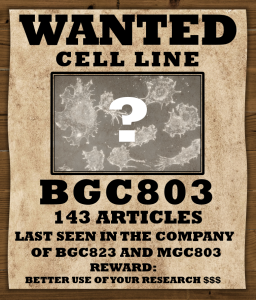Human cell lines represent key reagents for many research laboratories. Cell lines are often the first models that researchers choose for experiments such as gene manipulation and drug testing, as they are relatively accessible and inexpensive, particularly compared with mouse and other animal models.
However, cell lines also are prone to contamination by other faster growing cell lines. As a result, many human cell lines purported to represent particular tumor types have been found by genetic testing to be contaminated by other cancer cells. This potential for confusion poses a serious problem for researchers who want to study a particular cancer type but end up using cells from an unrelated disease.
Our team studies wrongly identified nucleotide sequence reagents in cancer research, such as PCR primers and gene knockdown reagents. Recently in the context of an undergraduate student project, we decided to also check the identities of cell lines in a small group of papers on the human gene miR-145, which codes for a microRNA. We found wrongly identified nucleotide sequences and cell lines in numerous articles about miR-145, but also what appeared to be five misspelled identifiers of contaminated cell lines.
Continue reading Misspelled cell lines take on new lives — and why that’s bad for the scientific literature
